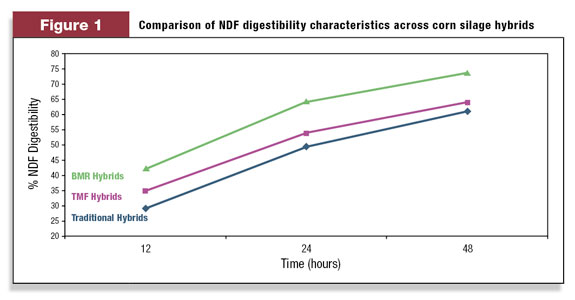High grain prices have many dairy producers and their nutritionists sharpening their pencils, looking for ways to reduce feed costs. One option is to replace a portion of the supplemental corn grain with high-quality corn silage that provides highly digestible fiber and contains more energy in the forage fraction, compared with silage made from grain corn hybrids.
With proper management, dairy producers can usually feed 60 percent, and potentially 70 percent, of the ration dry matter (DM) in the form of high-quality forages. This usually is accomplished by feeding primarily corn silage, allowing producers to reduce supplemental corn grain by as much as five pounds per cow per day.
When managed properly, high-corn silage diets typically generate improved feed efficiency (FE) and excellent income over feed costs (IOFC).
The challenge in feeding high-forage diets is the variability that can occur in corn silage, but especially in hay or haylage production. It’s important to realize that hybrids, soil fertility and drainage, weather and other factors vary by year, region and farm.
Add these variables to differences in management and facilities, and it’s easy to understand why cows in different herds may respond differently to high-forage rations.
Making the most of high-forage diets
In general, healthy, high-performance cows housed in comfortable facilities that are managed by high-performing managers will benefit most from high-forage, low-grain diets. But overall success depends on several factors.
Here are three keys to a successful switch to a higher-forage diet:
1. Understand tonnage requirements. A higher level of corn silage and/or haylage in the diet naturally requires harvesting or purchasing more tons to meet cows’ intake needs. For producers switching to high-quality BMR corn silage, we recommend producers plan for 20 to 40 percent more tonnage, depending on the level of corn silage fed and whether the entire herd is fed BMR.
In addition to acreage requirements, producers should consider their storage capabilities and make sure they can handle the added tonnage.
2. Maintain effective fiber to control digestion rate. What makes high-forage diets work is the quality and digestibility of the forage neutral detergent fiber (NDF). Because lab procedures and time points vary for neutral detergent fiber digestibility (NDFd) analyses, it’s difficult to provide absolute numbers as guidelines.

However, in general, BMR corn silage should have the highest NDFd compared with conventional silage hybrids grown under similar conditions.
Figure 1 shows average NDFd values for different types of corn silage hybrids analyzed by Cumberland Valley Analytical Services Inc., Maugansville, Maryland.
With any highly digestible corn silage, it’s important to maintain adequate forage particle size, or effective NDF (eNDF) in order to optimize rumen digestion and control passage rate.
When harvesting, chop at the proper moisture and recommended particle size (minimum ¾-inch, preferably one inch) and work with your nutritionist to ensure the ration contains adequate effective fiber.
For producers feeding corn silage at 60 percent or more of the total forage in the diet, finely ground dry shelled corn is a better choice for supplemental grain in comparison to high-moisture corn. A drier grain source digests more slowly, producing less acid load in the rumen.
3. Don’t dilute ration with poor-quality forage. If you are considering a switch to high-forage diets, make a commitment to feeding adequate amounts of high-quality forages. For BMR corn silage, we recommend feeding at a minimum of 15 pounds of DM per cow per day.
Higher BMR inclusion rates deliver a greater response in terms of feed intake and, consequently, milk production.
Diluting the diet with significant quantities of low-quality forages will likely reduce your success. However, in some situations, feeding up to a pound of finely chopped straw or a couple pounds of poorer-quality hay or haylage can help control rumen passage rate.
This is especially true if the high-quality forages are chopped too finely or eNDF is diminished by excessive handling or mixing.
Ration management red flags
With any ration change, it is important to increase forage level gradually over 10 to 14 days. When dairy producers switch to BMR corn silage, we recommend making one-third of the dry matter adjustment initially, waiting three to five days, making an additional one-third of the dry matter adjustment and then waiting an additional three to five days before making the final one-third of the adjustment.
During this adjustment period, it is important to monitor cows to make sure they are adapting well to higher levels of forages. Watch these four parameters and work with your nutritionist to fine-tune the diet if any red flags emerge.
1. Manure consistency. If feed is passing through the rumen too quickly, you may notice loose or inconsistent manure. A healthy manure pile stacks one to three inches in height with a dimple in the center where the last drop of manure fell.
If piles are flatter than one inch in height or are inconsistent from cow to cow, you may need to increase the effective fiber of the diet by adding finely chopped straw or another fiber source. Make sure TMR sorting is not causing the manure inconsistency.
Also watch for thin, off-color and/or bubbly manure or large undigested forage particles or grain kernels in the manure. All are potential indications of an issue with rumen passage rate, which may be remedied by adding more effective fiber.
2. Dry matter intake. Expect dry matter intake (DMI) to increase no more than two to four pounds per cow per day. High-producing groups of cows will increase the most and low cows may not increase DMI at all. If DMI increases more than this or varies significantly from day to day, inadequate effective fiber may be causing the feed to pass through the rumen too quickly. In this case, increase the eNDF in the diet.
3. Milk components. When feeding a higher-forage ration, you should not see a reduction in butterfat or protein content of the milk. The butterfat percentage for the whole herd should stay flat or increase with a high-forage ration.
A drop in butterfat percentage may indicate the diet forage particle size is too small and effective fiber should be added. Protein content should stay flat or increase slightly, but generally the change will not be as dramatic as the butterfat percentage.
4. Cud chewing. The herd’s cud-chewing patterns also provide clues to how cows are adapting to high-forage diets. When cows are resting after eating and are undisturbed, at least 50 percent should be ruminating.
If the percentage is consistently less and you observe one or more of the above situations, eNDF is likely too low. Look for ways to add fiber through dry hay or straw and/or back off the grain content of the ration.
In summary, dairy producers can formulate a more economical ration by feeding more high-quality forages and less grain. But management is essential. Proper whole-plant moisture at harvest is critical to fermentation, storage and feeding effectiveness.
Proper cut length and excellent kernel processing are important in making high-forage diets successful. Work closely with your nutritionist to maintain adequate effective fiber in the ration for optimum rumen digestion. PD

-
Phil Krueger
- Dairy Nutritionist
- Mycogen Seeds
- Email Phil Krueger








